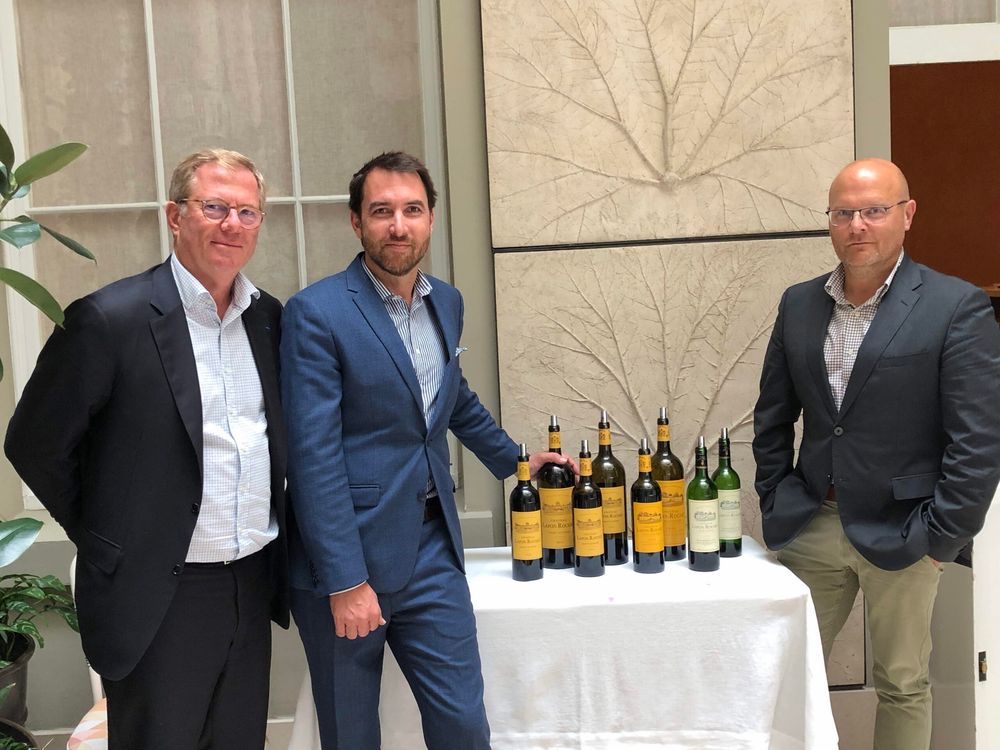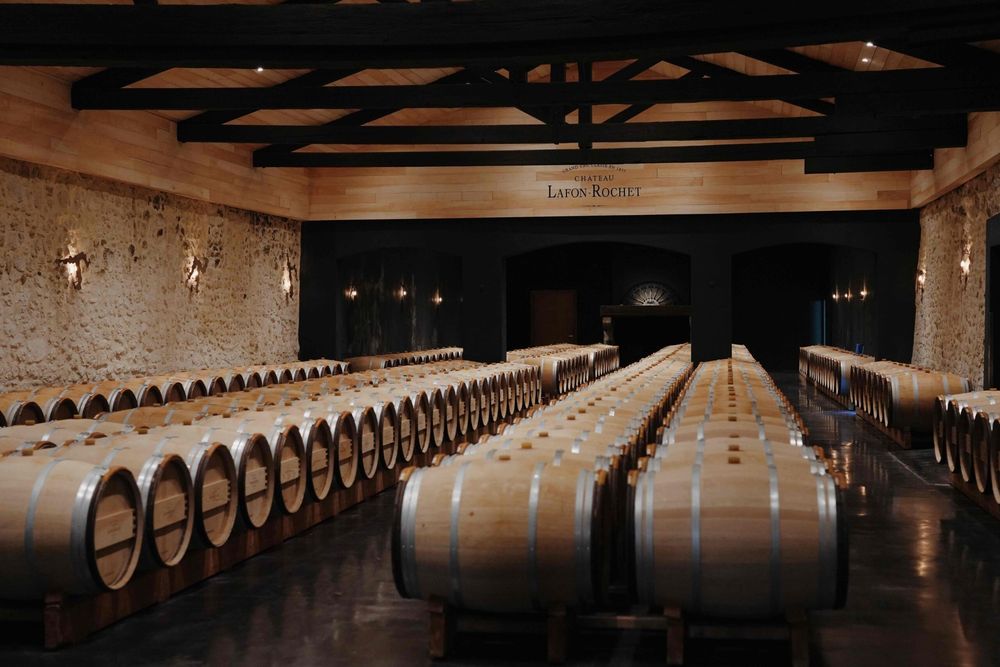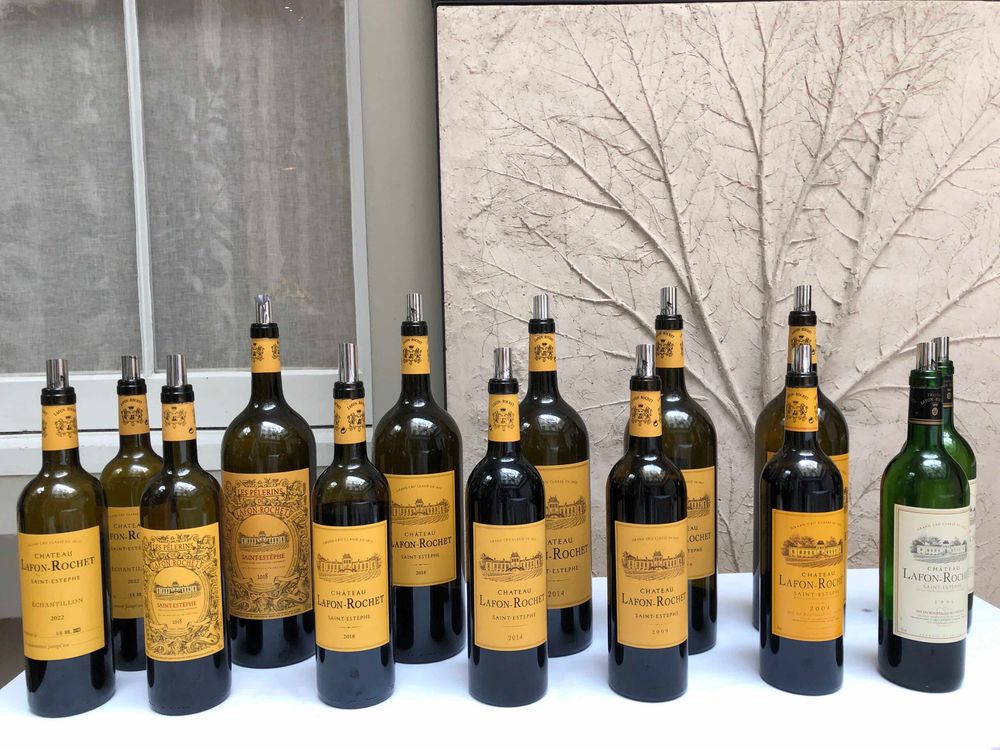“Lafon-Rochet is already in good shape before the takeover,” says Congé, “so for us, the key task is to further increase the quality and the château’s visibility.”

Aiming high: the new Lafon-Rochet team (l-r) Emmanuel Cruse, Augustin Lacaille, Christophe Congé, July 10, 2023
“Over the eighteen months since I took on the role, what struck me the most is how such a small team can make such good quality wines!” says Christophe Congé, the new managing director of Saint-Estèphe fourth growth Château Lafon-Rochet. The comment that comes from someone who spent the last 22 years working as the oenologist and wine operations director across Château Lafite Rothschild and Château Duhart Milon in Pauillac does carry a lot of weight.
“At Lafite, with 100 hectares of vineyard, they have 100 people in the team. Whereas we have 45 hectares in Lafon-Rochet, but merely 21 employees,” explains Congé, clearly impressed with the efficiency of his new team.
Château Lafon-Rochet was under the rein of the Tesseron family since 1960. The fourth growth estate might not be a household name but the improvement of the wine quality over the years has been impressive. In 2021, the Vignobles Cruse-Lorenzetti group took over Lafon-Rochet from the Tesserons, and in 2022, hired Congé as the MD.
“Lafon-Rochet is already in good shape before the takeover,” says Congé, “so for us, the key task is to further increase the quality and the château’s visibility.”
The latter is the main reason behind the team’s recent visit to London, meeting and getting feedback from the UK wine trade professionals. It also marked the first opportunity for Congé to introduce himself in his new role as MD, and to present his first vintage (2022) from Lafon-Rochet. He was accompanied by Emmanuel Cruse, director of Vignobles Cruse-Lorenzetti and co-owner of the estate, and the château’s commercial director, Augustin Lacaille.
Lafon-Rochet sold 80% of its total production en primeur, and the UK is its top market for the vintage 2020 and so far in the 5th place for the vintage 2022. “UK is clearly a very important market for us. There is a lot to be done to increase our visibility in the UK but at the same time, we are continuing our journey of improving the quality of the wine,” says Lacaille.
To achieve that, they aspired to make terroir-driven wine, and “precision” is the keyword. “The philosophy of the château stays unchanged under the new ownership,” says Cruse, “and that is to make the best wine possible. So we asked Congé how can we achieve that and he said he needs a new cellar with smaller vats. He will get that with our full support.” The new cellar project will start in 2025 and between now and then, Congé’s biggest task is to learn more about the new terroir.
“One of the first things I did since I joined was to buy a drone,” says Congé, “as this allows us to do soil mapping, observe vineyard health conditions, find missing vines, and do various analysis parcel by parcel.” But ultimately, his goal is to identify “intraparcels” which is to separate one parcel into two or three parts. “That was what Château Duhart Milon does, but we can’t do so in Lafon-Rochet as we don’t currently have any small vats,” Congé explains.

Barrel-room at Lafon-Rochet, May 2022
The appliance of science
The project of the new cellar will start in 2025 with new de-stemmers, optical sorters and vats ranging from 25hl to 90hl. Large oak ageing vessels will be introduced, including 400 and 500-litre barrels and 13hl casks. “Our wines do not lack the fruit intensity, but we need to gain the freshness and the elegant aromas derived from the wood ageing,” Congé says.
In terms of vineyard management, Lafon-Rochet began its conversion to organic viticulture in 2020, and 2024 will be the projected completion of organic certification. Both Congé and Cruse are firm supporters of traditional Bordeaux varieties and believe they must adapt to climate change. “This is why we have created a small research department and we meet every two weeks to discuss any potential issues and positive progress,” says Congé. “It is important for me to take a scientific approach and not rely on feelings or simply follow what everyone else is doing.”
This means that they are not experimenting with new grape varieties but are focused on ways to mitigate the impact of global warming, such as later pruning for Merlot, for example, and utilising their unique vineyard parcel with blue clay to its full potential.
So far, the team is very pleased with their 2022 vintage. “It was a difficult vintage. There was frost, mildew and very hot days, though the nights were fresher than in 2003,” Congé explains. The wine is deep and dense with a dark fruit-coated mid-palate and the elegance is showing through. “For me, the goal is to have constant high-quality wines, so we can place Lafon-Rochet at the right place,” says Congé.
As for who they aspire to be? Congé mentioned Calon-Ségur without hesitation. “I have known Calon-Ségur since twenty years ago. At that time, they made good wine, but were not very well-known, just like Lafon-Rochet today. But see what they have achieved. They are making really good wines!” says Congé. Better marketing and improving the vinification were some of the reasons behind Calon-Ségur’s success and it took them around ten years to achieve that. “For us, with the direction we are heading, I would say in five to ten years, we should also be able to succeed,” Congé concludes confidently.
Wines that we tasted at the Spring Restaurant, Somerset House in July 2023.

Vertical tasting of Lafon-Rochet
Les Pèlerins 2018, 14.5% abv (Second wine)
Cabernet Sauvignon 56%, Merlot 28%, Petit Verdot 6%
Crunchy and fresh blackberry, spices, with supple tannins and is very approachable.
Lafon-Rochet 2018, 14.5% abv
Cabernet Sauvignon 64%, Merlot 24%, Petit Verdot 6%, Cabernet Franc 4%
Pronounced vanilla and spices on the nose leading to intense juicy blackcurrant note on the palate with fine-grained tannins.
Lafon-Rochet 2014, 13.5% abv
Cabernet Sauvignon 66%, Merlot 26%, Petit Verdot 4%, Cabernet Franc 4%
Very fresh and subtle with great acidity. Classic style with more powerful tannin structure.
Lafon-Rochet 2009, 14% abv
Cabernet Sauvignon 67%, Merlot 27%, Petit Verdot 5%, Cabernet Franc 1%
Some development with notes of prune, spices and leather, with charming freshness and vibrant fruit characters.
Lafon-Rochet 2004, 13% abv
Cabernet Sauvignon 46%, Merlot 51%, Cabernet Franc 3%
Garnet colour, expressive notes of crunchy blackcurrants with a hint of savoury finish. Round and dense on the mid-palate with an elegant tannin structure.
Lafon-Rochet 1996, 13% abv
Cabernet Sauvignon 40%, Merlot 56%, Cabernet Franc 4%
Violet, cassis, minty, and blackberry, with a hint of tobacco, wood spices and a savoury finish.

Chalk stream trout paired with Lafon-Rochet 2014 and 2019










































